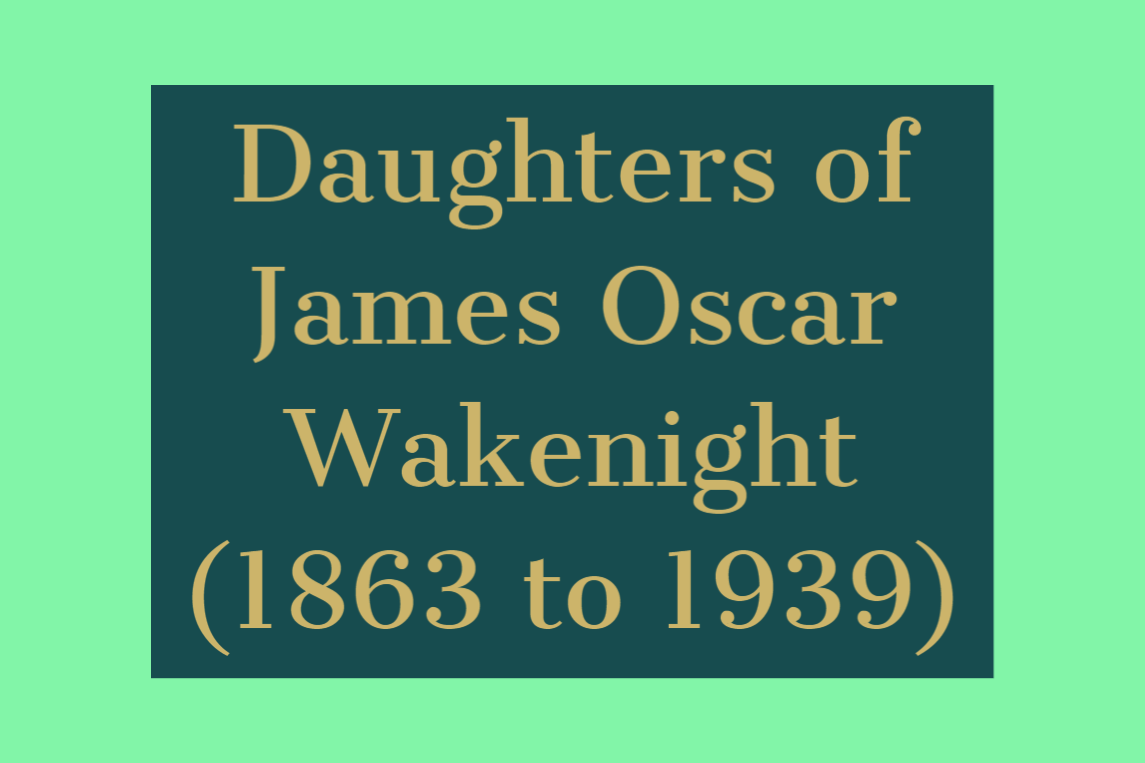Three of the daughters were childless. Could this have been a conscious decision or caused by a genetic abnormality passed down through their parents?
Five known daughters were born to James Oscar Wakenight (1863 to 1939) and Susan Regina Baier (1871 to 1934).
Minnie was born in 1892 in Nebraska. She last appeared in a 1914 Omaha City directory listing. She worked as a clerk for Hayden Brothers, an iconic Omaha City department store.
Minnie most likely married. I could find no information on her after the 1914 listing.
Pauline was born on 25 OCT 1895 in Nebraska. She died in 1974 in Omaha, Douglas County, Nebraska.
Pauline married Roy C Bartlett in 1915 in Omaha, Douglas County, Nebraska. No known children were born to this marriage.
Pauline and Roy adopted a child, Marceline Maryellen Bartlett, who was Roy’s niece.
Marceline Maryellen Bartlett was born on 17 MAR 1929 in Council Bluffs, Pottawattamie County, Iowa. She died on 17 MAY 2007 in Boynton Beach, Palm Beach County, Florida.
Roy C Bartlett was born on 5 JAN 1892 in Arlington, Washington County, Nebraska. He died in 1972 in Omaha, Douglas County, Nebraska.
Nettie was born on 6 JUN 1897 in Nebraska. In a 1916 Omaha City directory listing, she was listed as an operator for the Nebraska Telephone Company. She died one year later on 13 JUN 1917 in Omaha, Douglas County, Nebraska. She was 20 years old.
Elizabeth was born on 19 APR 1899 in Rockville, Sherman County, Nebraska. I do not know when she died.
Elizabeth married Henry J Mielke in 1925 in Omaha, Douglas County, Nebraska. No known children were born to this marriage.
Henry J Mielke was born on 17 JAN 1897 in Nebraska. He died in 1980 in Omaha, Douglas County, Nebraska.
Henry’s father was Heinrich Adolf Mielke. He was born on 14 JUL 1862 in Germany and baptized in Danzig-Westpr, Deutschland. He died on 17 FEB 1947 in Omaha, Douglas County, Nebraska.
Henry’s mother was Kate Petz. She was born on 10 AUG 1867 in Germany. She died on 29 APR 1953 in Omaha, Douglas County, Nebraska.
Rena was born on 20 NOV 1902 in Omaha, Douglas County, Nebraska. She died on 25 APR 1989 in Omaha, Douglas County, Nebraska.
Rena married Maurice H Smith on 18 JUN 1924 in Council Bluffs, Pottawattamie County, Iowa. No known children were born to this marriage.
Maurice H Smith was born on 8 JUN 1903 in Omaha, Douglas County, Nebraska. He died on 20 FEB 1967 in Fremont, Alameda County, California.
Maurice’s father was Thomas Smith. He was born in 1865 in Iowa. I do not know when he died.
Maurice’s mother was Harriet Margaret Clark. She was born in 1868 in Iowa. She died on 11 APR 1923 in Omaha, Douglas County, Nebraska.
Notes on the Children:
I would like to note that none of these women had children. Nettie died before she could marry. Minnie, I could not trace after 1914.
Yet, what about the remaining three women? Pauline, Elizabeth, and Rena?
I discovered an article on the CDC (Center for Disease Control) website, that may supply an answer. It is a study of three generations of women born in 1910, 1935, and 1960. The article states:
“. . . women born in 1910 were equally likely to have no, one, or two children.”
The three women were born before this date (1895, 1899, and 1902 respectively). Yet, they may have still lived under the same social and economic conditions that affected the generation of women born in 1910.
Another article on the HuffPost (Huffington Post) suggests that genetics could affect fertility:
“. . . many people are unable to conceive or carry a pregnancy successfully to term due to genetic and chromosomal abnormalities.”
Genetics could also be passed down through the parent’s DNA:
Nettie died at age 20. Robert died at age 22. Leonard died at age 39.
I do not know the causes of deaths for these three individuals. They could have been the result of an injury or illness.
Yet, I wonder if James and Susan could have passed down a genetic disorder that affected some of their children. Medline Plus states:
“. . . if a couple has a child with an autosomal recessive disorder, the chance of having another child with the disorder is still 25 percent (or 1 in 4). Having one child with a disorder does not “protect” future children from inheriting the condition.”
Of the seven children, three died at a fairly young age and three were childless. Could one or more of the factors mentioned above played a part in these events?
Notes:
For more information on this part of the Wakenight family, please visit Sharon Strow’s website, “Descendants of Daniel Wakenight.”
Sharon listed only one child, James William Wakenight, on her website that was born to James and Susan. Yet, US census records confirm that they had at least seven children.
Creating Your Family Tree
Interested in building a great family tree? Remember these important steps:
Look in your photo albums. You may have old pictures that your parents or grandparents gave you. Or, ask them for copies of photos that they have in their possession. Many people will write names and dates on the backs of photographs. Letters, diaries, and family bibles are also an excellent source for births, marriages, and deaths.
Talk to your older relatives to find out about your ancestry. They may relate stories about an ancestor that you can add to your family tree. Family history is usually not found in newspapers. It is more of a verbal memory that is passed down from generation to generation.
Find the right family tree builder that suits your needs. You can choose one that has a paid subscription like Ancestry.com. There are also free sites like FamilySearch.org.
When you start building your family tree, add documentation to your ancestor’s profile. The records can include birth, marriage, death, census, military, city, and county directory listings. Any information that you can find will help create a life story about your ancestor.
If you have a unique surname, like Wakenight, you may find databases on the internet that are useful in your search. I use SurnameDB.com for my English surnames. There are many others on the internet for other countries like Ireland, Italy, and Germany.
Genealogy is the study of a person’s “line of descent.” As you create your family tree, you would typically start with one individual and go “back into time.” You would add their parents, grandparents, and so on. There are also family trees that go “forward into time.” Many of these family trees start with a famous person, such as a president or royalty, and move forward into the present time. The purpose of this type of pedigree is to establish a person’s bloodline to that famous person.
There is no limit on how big your family tree can grow. The blank canvas is there for you to use. Cherish your family history, and it will be there for generations to come!



Leave a Reply